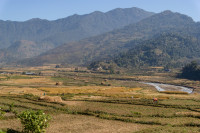Opinion
Climate change firsthand
Farms are being affected by crop diseases and pests that were unknown in the past
Dharmendra Kalauni
I was in Grade 8 when I first heard about and experienced the cruelty of extreme weather. We live in the Tarai plains in Nepal’s far west, which is one of the most underdeveloped and food insecure regions in the country. I belong to a middle class family, and my parents are farmers. Most of the agricultural land is rain-fed, and irrigation facilities are inadequate. It was the rice transplanting season, and we had been waiting for the monsoon rains for more than two weeks. The sun was scorching hot, the tube well had dried up, we had no irrigation facilities, and we were running late to transplant paddy.
During dinner, my mother expressed sadness at the delayed monsoon. She was worried that we could face food shortages due to the effects of climate change. We used to irrigate the rice seedlings by bringing water in a bucket from the hand pump, which was difficult work. We have land in the mid-hills too where my grandparents live. We have mandarin groves there which provide us cash income on which my grandparents live.
Forced, unwanted changes
About a few years ago, when I started my undergraduate studies, I found out that our mandarin groves had been hit by disease and pests which were unknown in the past. The trees began to wilt, their leaves turned yellowish and the root began to rot. Eventually, the mandarin trees fell down. Grandfather has invested a lot of money to cure the disease. He has replaced all the old local varieties and planted new hybrid varieties. But that didn’t give satisfactory results either, so grandfather was compelled to cut down all the mandarin trees and plant wheat instead. I am now in the final year of my undergraduate studies, and I found out that this misfortune had been caused by climate change which has hit rural livelihoods.
Another thing that I have come to know is about the sources of drinking water in the mid-hills. Springs and wells are the major sources of water for drinking. Many sources have dried up and the rest are on the verge of drying up. Those that are still working have a decreased water level. This is deeply distressing for rural people in the hilly regions of Nepal. Many international NGOs and government agencies are working in collaboration to find out the cause of the problem.
Another effect of climate change that I have experienced first hand is the spread of mosquitoes from the Tarai region to the hills. In the past, there were no such pests in the hilly regions because of the cold climate at the higher elevation. Currently, mosquitoes are able to survive in the hills due to rising temperatures caused by global warming. As a result, the lives of people in the hills have become more difficult.
Don’t blame fate
When I was a child, I used to think that all the bad things happening around us were caused by a curse. But as I grew up, I realised that it was not because of ill fortune but the changing climate which is unstoppable and dynamic. Climate change is a matter to be discussed widely. People must be made aware of the undesirable consequences that may result due to ignorance. Till now, there have been some changes during the seasons and we have had to experience a few discomforts. But if climate change continues at this pace and temperatures start rising at a faster rate, life is going to be difficult.
The Nepali people are vulnerable to climate change, so we have to start making plans for the next 30 years with certain achievable goals to mitigate its effects. We are sure to lose the wildlife, our normal weather, our stable nature and more. So, adaptation and mitigation plans must be put into place from the local to the national levels to strengthen the climate policy.
In the context of Nepal, it is of utmost importance to plan at the local level since farmers are not aware about climate extremities. In the agriculture sector, farmers urgently need an early forecasting system because most of the agricultural land is rain-fed, and most of them are highly dependent on the monsoon. To reduce the impact of climate extremities, we need to adopt adaptation strategies. Shifting from annual to perennial crop farming and growing maize instead of rice in the Tarai may be the one of the suitable strategies to escape the drought.
It’s a bitter fact that rice transplantation is still done using rainwater collected in ponds. The government should promote dry seeded rice. Agro forestry and no-till farming can be practiced in the mid-hills as they are sustainable practices and better than sole and mono cropping. In addition, adaptation activities and mitigation strategies should be promoted and implemented by the concerned authorities.
Kalauni is pursuing a BSc at the Agriculture and Forestry University, Nepal




 13.12°C Kathmandu
13.12°C Kathmandu










